| |
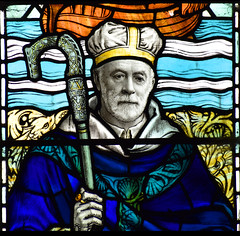 |
|
The hills roll in from the
west, and make gentle folds in the countryside
between Stowmarket and Hadleigh. Some of the
valleys are quite dramatic, and in one of the
steepest sits the village of Rattlesden.
Rattlesden is a large village in a wide parish,
and in fact the parish contains several other
settlements. One of them, Hightown Green, is
bigger than many other Suffolk villages. But it is Rattlesden itself that
contains the parish church, and what a dramatic
setting! Half-timbered houses clamber the slopes
either side of the splendidly named River Rat. On
the south side they are particularly grand, and
include a fine old pub. There is another pub on
the north side. The churchyard drops dramatically
away to the south-east. A steep path descends
from the road above the graveyard giving a grand
view of the building, and it doesn't take much to
see that St Nicholas is a little unusual.
Although the assemblage of nave, clerestory,
aisles and chancel are familiar 15th century
rebuildings in this prosperous area, the tower is
a little out of the ordinary. Uncastellated, but
with a little wooden spire, it was remodelled by
Sir Arthur Blomfield in the later years of the
19th century. Replacing an earlier spire which
had fallen, but avoiding Richard Phipson's
psychedelic fantasies at nearby Woolpit and Great
Finborough, he produced something much more
austere, although in its way just as singular.
|
The shortness of the spire create
an effect a bit like a hat on the thin tower. Two
clasping pencil-like buttresses rise on the west side,
and the tower appears to lean into them, but this is
perhaps just an optical illusion.The exterior took its
present form in four stages. Firstly, the original nave
was built in the 13th century, probably replacing a Saxon
or Norman building. A hundred years later, the tower was
added. Next, the dramatic remodelling occured in the 15th
century, when the little church was transformed by the
addition of Perpendicular aisles and a clerestory. The
clerestory is a beautiful one, and above its windows,
between the battlements, is a sequence of holy symbols.
They are for the Blessed Virgin and most of the
disciples, but also include St Edmund of East Anglia and
St Etheldreda of Ely, a reminder that the Priory there
was one of the patrons of the living here. The pinnacles
finish it all off a treat.
You step in through the south porch into a wide, urban
interior. Apart from some medieval benches in the south
aisle, the pews were all replaced with modern chairs,
which always looks good and is always a blessing to
anyone who actually has to sit on the things.
St Nicholas has an excellent range of 20th Century glass
by William Aikman, four windows installed over a period
of almost twenty years. The earliest is the war memorial
window in the south aisle depicting St George flanked by
scenes of the angel staying Abraham's hand as he attempts
to sacrifice his son Isaac, and David about to face up to
Goliath and dispatch him. Next came the best of the
sequence, to the children of the parish in 1927. Although
the central figure of Christ is unremarkable, he is
flanked by children of the world in different national
dress, and beneath are images of the Rattlesden font and
reredos, still easily recognisable today. Above in the
upper lights are the figures of six significant Biblical
teenagers, Mary at the Annunciation, Joseph in Egypt,
David the Shepherd, the young St John the Baptist,
Jairus's daughter and Huldah the Prophetess who appears
in the first Book of Chronicles.
The 1930s brought two further
windows, an Adoration of the Angels at the east end of
the south aisle, and up in the chancel a most curious
memorial to a rector of Rattlesden, Joseph Russell
Olerenshaw. It depicts him photographically as St
Nicholas. On the left, Thomas Rattlesden greets Henry VII
outside the gates of Bury Abbey, whilst on the right St
Edmund of East Anglia is martyred.
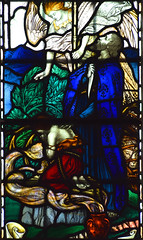 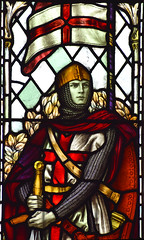 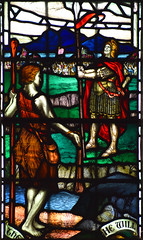 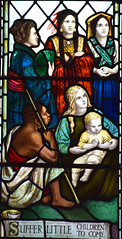 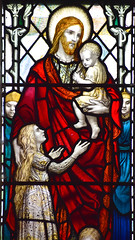 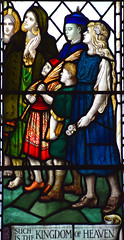
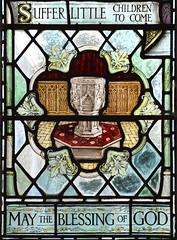 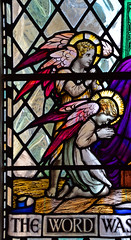 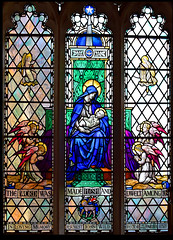 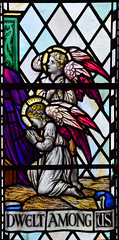 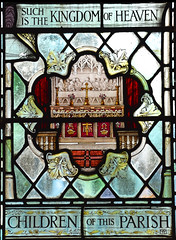
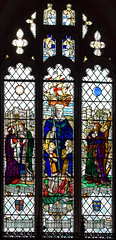 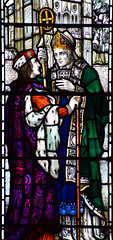  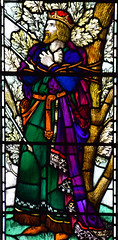  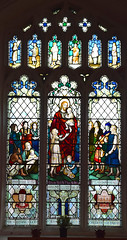 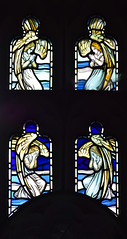
There are collections of fragments
of medieval glass in the north aisle and west window
beneath the tower. But what makes St Nicholas remarkable
is that it has one of the most complete and precise
reconstructions of a rood screen system in England. It
was constructed between 1909 and 1916 to the designs of
George Fellowes Prynne. It is based on a medieval
fragment surviving at the west end. One of the reasons it
is so impressive is that it does not try to recreate a
medieval effect, but rather serves to demonstrate the
actual mechanics of how the whole thing worked. If you
are lucky enough to be allowed through the locked grill,
the original roodloft stair in the south aisle takes you
up into the loft of the parclose screen as at Dennington,
and then up a ladder and through an opening in the south
arcade across into the roodloft itself. This crosses to
the north arcade, beneath the elegant arch. The rood is a
grand thing; however, I suspect that the original rood
here may have been even bigger, hence the backlighting
from the triple lancet window in the east wall of the
nave. The other little opening may have been designed to
enclose a sanctus bell, which would have been rung from
the rood loft.
The doors in the rood
screen are very heavy, effectively separating the
chancel from the nave, and the chancel itself is
fitted as a choir, which must have been the very
thing at the turn of the 20th century. Above all
this, this vision of the medieval is completed by
the angel roof installed in the 1880s. Imagine
all this wood ablaze with colour, and you'll
begin to get a feel for what this place must have
been like when it was first in its current form
towards the end of the 15th century.
The chancel is grand without being overstated.
The east window depicts an unremarkable Ascension
by Clayton & Bell of the 1880s. Looking back
towards the nave and the tower arch, you'll see
that it is, unusually, raised up a step, as if to
improve the view. The railings dividing it off
are actually the former communion rails removed
from nearby Kettlebaston at the time of its
Anglo-catholic makeover. Within the tower arch a
quaint wrought iron staircase spirals into the
belfry.
Back in the nave are several reminders of the
connections between this parish and the United
States. The Kimball family came from here, and
their ancestors have installed a plaque in the
north aisle as well as paying for the bringing
together of fragments of medieval glass in a
north aisle window. The north aisle chapel
remembers the presence of the USAAF on Rattlesden
airfield during WWII. The 'K' on the prayer desk
recalls not only the Kimballs, but also that it
was the operation letter for planes flying from
the base. |
|
 |
|
|

